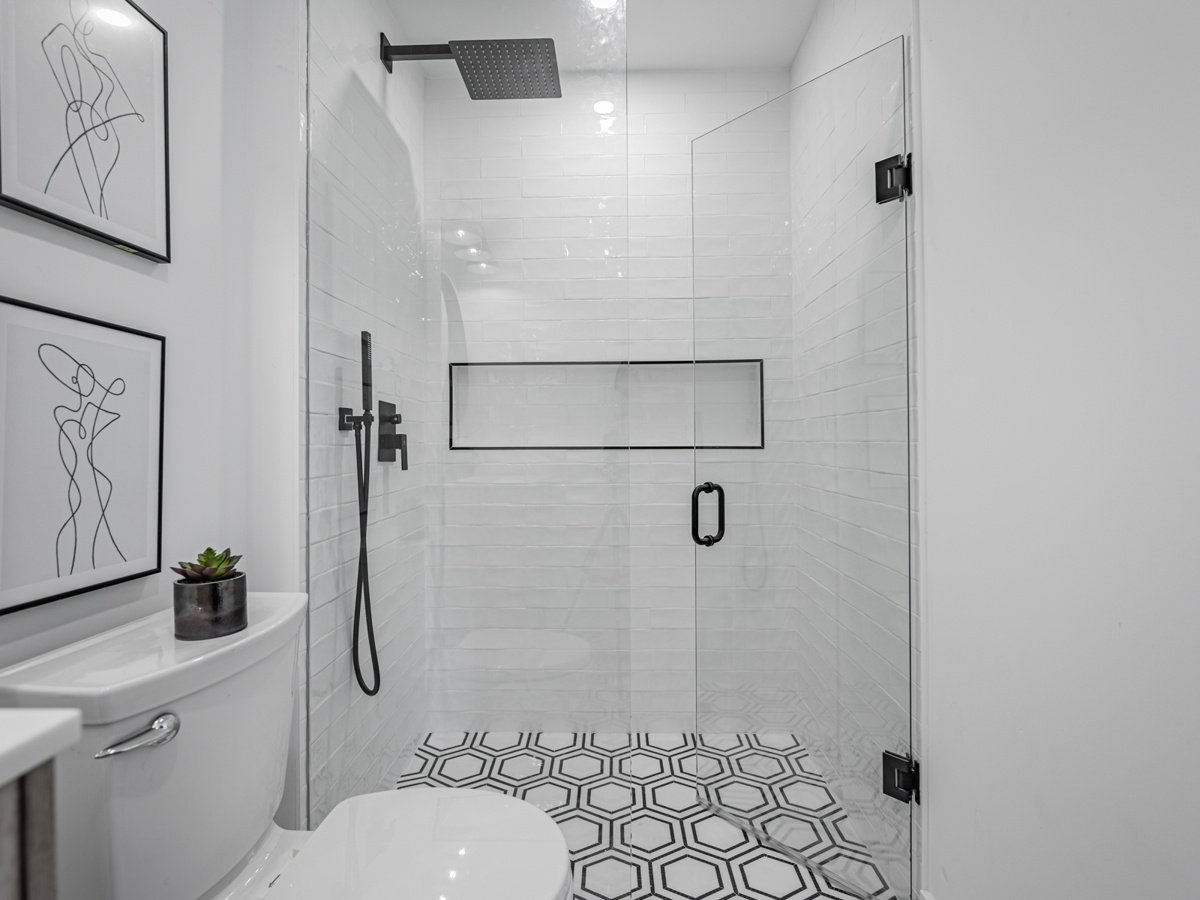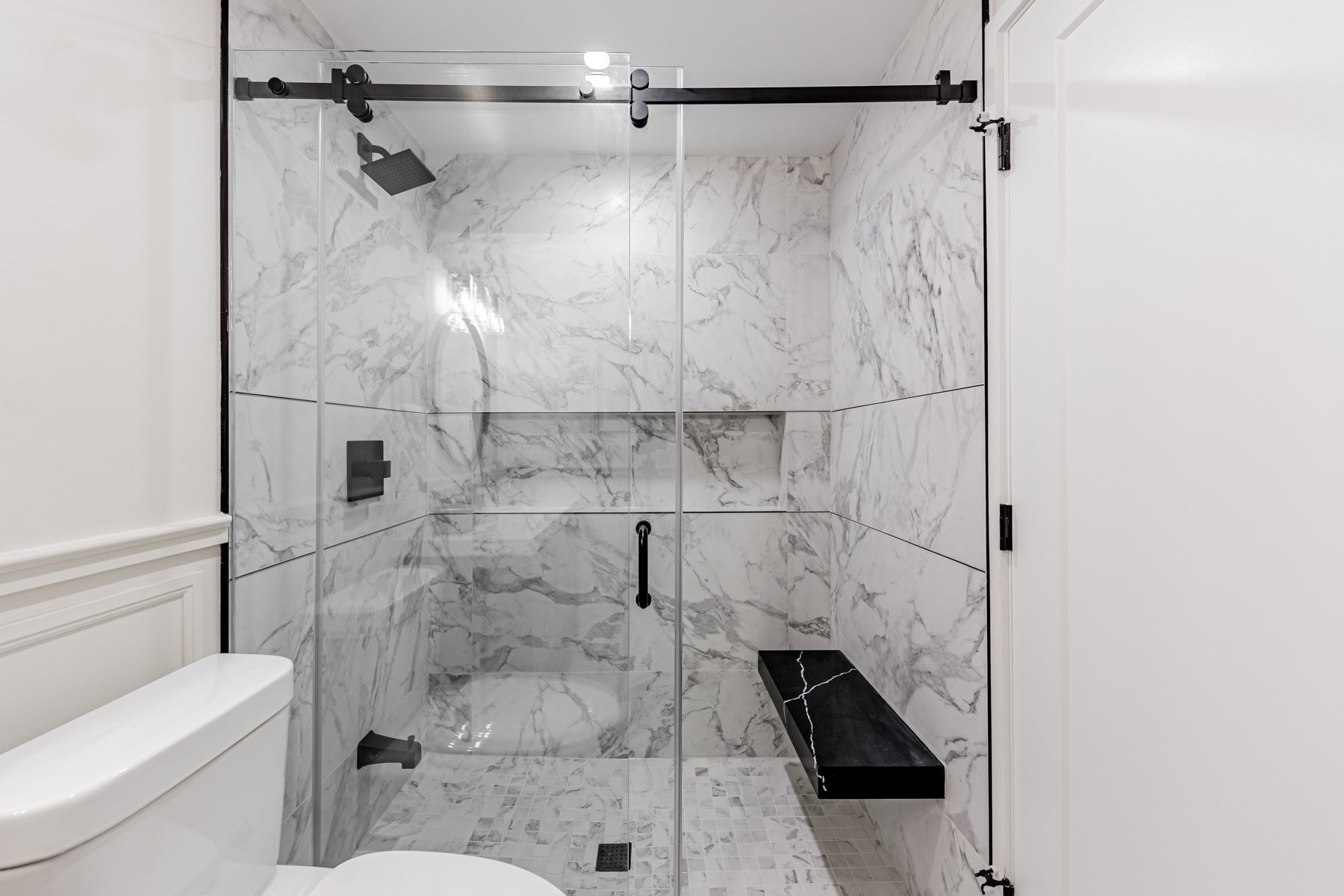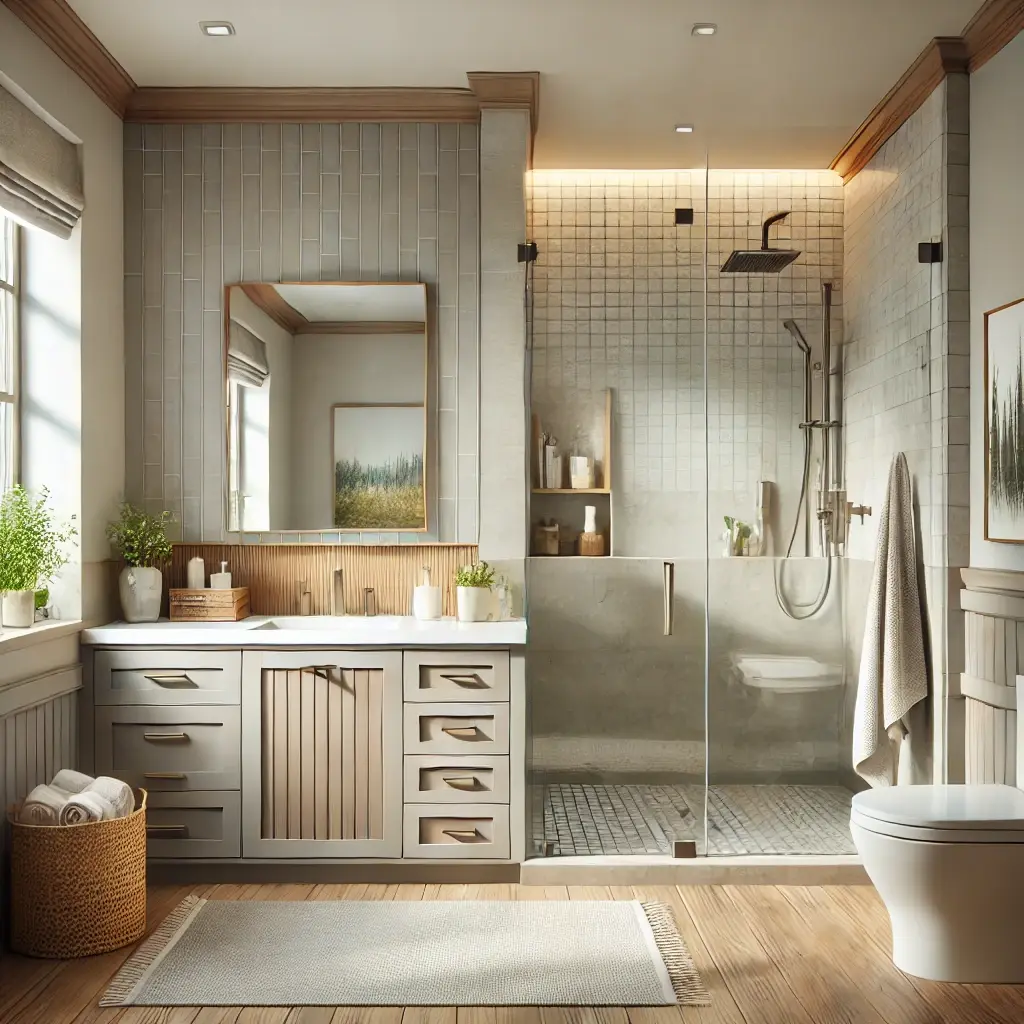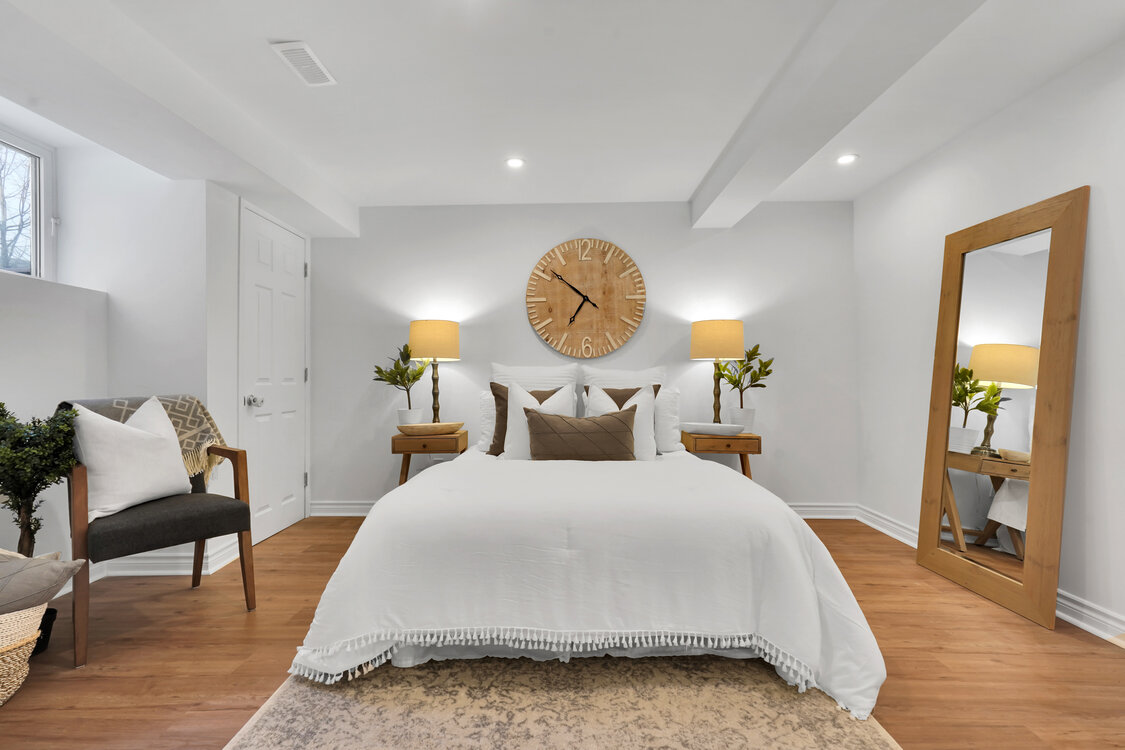Multifunctional Steam Room And Shower In A Low-Ceiling Bathroom
Transform your compact bathroom into a luxurious retreat by designing a multifunctional steam room and shower, even with a low ceiling.
10 min read
Quacy Barry Jul 29, 2024 9:04:32 PM

Renovating your bathroom can be an exciting yet challenging task. With the right planning, design, and execution, you can transform your old bathroom into a modern, functional, and stylish space. Whether you're looking to update fixtures, increase storage, or completely overhaul the design, this comprehensive guide to Whitby bathroom renovations will provide you with all the information you need to make your renovation project a success.
Planning is the cornerstone of any successful bathroom renovation. A well-thought-out plan helps ensure that the project stays on track, within budget, and meets your design expectations. It involves determining the scope of the renovation, setting clear goals, and outlining the steps needed to achieve them. Without proper planning, you risk facing unexpected challenges that can delay the project and increase costs.
Establishing a realistic budget is crucial for your renovation project. Consider all potential expenses, including materials, labour, permits, and unexpected costs. It's wise to allocate a contingency fund for unforeseen issues that may arise during the renovation. Understanding your financial limits will help you make informed decisions and prioritize the most important aspects of your bathroom makeover.
Your bathroom should reflect your personal style and complement the overall aesthetic of your home. Start by gathering inspiration from magazines, websites, and social media platforms. Identify key elements that appeal to you, such as colour schemes, fixtures, and layout designs. Whether you prefer a modern, minimalist look or a more traditional, cozy feel, having a clear vision of your desired style will guide your renovation decisions.
A detailed timeline is essential to keep your renovation project on schedule. Break down the project into manageable phases, such as demolition, plumbing, electrical work, and finishing touches. Assign realistic timeframes to each phase and consider factors like the availability of contractors and delivery times for materials. A well-structured timeline helps prevent delays and ensures a smooth workflow.
Modern bathroom designs emphasize clean lines, minimalism, and functionality. They often feature neutral color palettes, sleek fixtures, and innovative storage solutions. Floating vanities, frameless glass showers, and wall-mounted toilets are popular choices for a contemporary look. Incorporating high-quality materials like porcelain tiles and quartz countertops adds a touch of luxury to the space.
Traditional bathroom designs exude warmth and elegance. They typically include classic fixtures, such as clawfoot tubs, pedestal sinks, and ornate mirrors. Rich colour schemes, detailed mouldings, and natural materials like marble and wood create a timeless appeal. Incorporating antique or vintage elements can further enhance the traditional aesthetic of your bathroom.
Space-saving designs are essential for smaller bathrooms. Compact fixtures, such as corner sinks and wall-mounted toilets, help maximize floor space. Vertical storage solutions, like tall cabinets and shelving units, can free up valuable surface area. Consider installing a walk-in shower instead of a bathtub to create a more open and airy feel.
Eco-friendly bathroom designs focus on sustainability and energy efficiency. Incorporating low-flow toilets, faucets, and showerheads can significantly reduce water usage. Choosing environmentally friendly materials, such as recycled glass tiles and bamboo flooring, minimizes your environmental impact. Additionally, installing energy-efficient lighting and ventilation systems contributes to a greener home.
The right flooring can enhance the look and feel of your bathroom. Popular choices include ceramic and porcelain tiles, which are durable, water-resistant, and available in a wide range of styles. Natural stone, like marble and granite, offers a luxurious aesthetic but requires regular maintenance. Vinyl and laminate flooring are cost-effective alternatives that provide a waterproof and easy-to-clean surface.
When selecting wall materials, consider both aesthetics and functionality. Ceramic tiles are a versatile option, available in various colours, shapes, and sizes. For a more modern look, large-format tiles create a seamless appearance with fewer grout lines. Alternatively, beadboard or wainscoting can add a touch of traditional charm. Waterproof paint or wallpaper is also an option for adding colour and pattern to your bathroom walls.
Countertops and vanities are focal points in any bathroom. Quartz and granite are popular choices for their durability and resistance to moisture and stains. Solid surface materials, like Corian, offer seamless integration with sinks and backsplashes. For a more budget-friendly option, laminate countertops come in various styles and finishes. Custom-built vanities provide additional storage and can be tailored to fit your space perfectly.
Choosing the right fixtures and fittings can elevate the functionality and style of your bathroom. High-quality faucets, showerheads, and towel bars are essential for everyday use. Consider features like water-saving technology and adjustable settings for added convenience. Coordinating the finish of your fixtures, such as chrome, brushed nickel, or matte black, ensures a cohesive and polished look.
Hiring a reliable contractor is crucial for a successful bathroom renovation. Start by seeking recommendations from friends, family, and online reviews. Verify credentials, such as licenses and insurance, and request references from previous clients. A trustworthy contractor should provide a detailed estimate, clear communication, and a portfolio of completed projects.
Collaborating with a professional designer can help bring your vision to life. Designers offer expertise in space planning, material selection, and colour coordination. They can create detailed plans and 3D renderings to visualize the final result. Working with a designer ensures that your bathroom renovation is cohesive, functional, and aesthetically pleasing.
Understanding local permits and regulations is essential for a legal and safe renovation. Depending on the scope of your project, you may need permits for plumbing, electrical work, and structural changes. Consult with your contractor or local building authority to ensure compliance with all necessary codes and regulations. Failing to obtain the required permits can lead to fines and complications down the line.
The cost of hiring professionals for your bathroom renovation can vary widely based on factors like project size, complexity, and location. It's important to obtain multiple quotes and compare them carefully. While hiring professionals adds to the overall cost, their expertise and efficiency can save you time and money in the long run. Consider the value of a well-executed renovation that enhances your home's comfort and resale value.
If you're considering a DIY bathroom renovation, having the right tools and materials is essential. Basic tools include a hammer, screwdriver set, power drill, level, tape measure, and utility knife. Specialized tools, such as a tile cutter, plumbing wrench, and stud finder, may also be necessary. Ensure you have all the required materials, including tiles, grout, plumbing fixtures, and paint, before starting your project.
Built-in storage solutions offer a seamless and organized look. Consider installing recessed shelves in shower areas or above the bathtub. Built-in cabinets and drawers under the vanity provide ample storage without occupying additional floor space. Medicine cabinets with mirrored fronts offer both storage and functionality.
Creative shelving solutions can enhance both storage and aesthetics. Floating shelves provide a minimalist look and can be placed at various heights for accessibility. Corner shelves make use of otherwise wasted space. Open shelving units offer easy access to frequently used items and can be styled with decorative accents.
Utilizing vertical space is essential in smaller bathrooms. Tall cabinets and shelving units can store towels, toiletries, and cleaning supplies. Over-the-toilet storage units are a practical solution for maximizing space. Wall-mounted hooks and racks keep items off countertops and floors, creating a clutter-free environment.
Natural lighting creates a bright and inviting atmosphere in your bathroom. If possible, consider enlarging windows or adding skylights to increase natural light. Frosted or textured glass provides privacy while allowing sunlight to filter through. Light-coloured walls and reflective surfaces can also enhance the effect of natural light.
Artificial lighting plays a crucial role in bathroom functionality and ambiance. Layered lighting, including overhead, task, and accent lighting, ensures adequate illumination for various activities. LED lights are energy-efficient and long-lasting. Dimmer switches allow you to adjust the brightness to suit different moods and tasks.
Lighting enhances the overall bathroom experience by creating ambiance. Consider adding sconces or pendant lights for a touch of elegance. Under-cabinet lighting and LED strips provide subtle, indirect illumination. Candles or battery-operated lights can create a relaxing spa-like atmosphere for unwinding after a long day.
Proper ventilation is essential to prevent moisture buildup, mould growth, and unpleasant odours in your bathroom. Inadequate ventilation can lead to long-term damage to walls, ceilings, and fixtures. Ensuring adequate airflow helps maintain a healthy and comfortable environment.
Various ventilation systems are available to suit different bathroom sizes and configurations. Exhaust fans are the most common solution, removing moist air and odors. Window vents provide natural ventilation if your bathroom has windows. Inline fans can be installed in the attic to ventilate multiple bathrooms or larger spaces.
When installing a ventilation system, consider the size of your bathroom and the type of fan needed. Position the fan near the shower or bathtub for optimal moisture removal. Ensure the exhaust duct leads outside to prevent recirculating moist air. Regularly clean and maintain the fan to ensure efficient operation.
Smart showers and tubs offer advanced features for a luxurious experience. Digital controls allow you to set precise water temperatures and flow rates. Some models include built-in speakers, lighting, and aromatherapy options. Wi-Fi connectivity lets you control your shower or tub remotely via a smartphone app.
Heated floors and towel racks add comfort and warmth to your bathroom. Radiant floor heating systems are energy-efficient and provide even heat distribution. Heated towel racks keep towels warm and dry, adding a touch of luxury to your daily routine. These features can be programmed to operate at specific times for convenience.
High-tech toilets offer numerous features for enhanced hygiene and convenience. Bidet functions, heated seats, and automatic flushing are common features. Some models include self-cleaning capabilities and air purification systems. Smart toilets can be controlled via a remote or smartphone app for a personalized experience.
Choosing budget-friendly materials can help reduce renovation costs without compromising quality. Laminate or vinyl flooring mimics the look of natural stone or wood at a fraction of the cost. Prefabricated shower enclosures are more affordable than custom-built options. Consider repurposing existing fixtures or furniture to save money.
Installing energy-efficient fixtures can lower utility bills and reduce environmental impact. Low-flow toilets, faucets, and showerheads conserve water without sacrificing performance. LED lighting uses less energy and lasts longer than traditional bulbs. Energy-efficient ventilation systems ensure proper airflow with minimal power consumption.
Reusing and recycling materials is an eco-friendly and cost-effective approach to bathroom renovations. Instead of buying new fixtures, salvage and refurbish old ones. Use reclaimed wood for shelving or countertops. Donating or selling unused materials and fixtures can offset some renovation costs.
Current trends in bathroom colour schemes include neutral tones, such as white, gray, and beige, for a clean and timeless look. Bold colours like navy blue, emerald green, and matte black are also gaining popularity for adding a dramatic touch. Combining different textures and finishes creates a dynamic and visually appealing space.
Modern fixture trends focus on sleek designs and innovative features. Matte black and brushed gold finishes are popular choices for faucets, showerheads, and hardware. Wall-mounted and freestanding tubs add a luxurious feel. Touchless faucets and smart mirrors with built-in lighting and Bluetooth speakers enhance functionality and convenience.
Innovative design features can transform your bathroom into a stylish and functional oasis. Curbless showers create a seamless transition from the bathroom floor, making them accessible and visually appealing. Floating vanities provide an open and airy feel while also offering storage. Integrated lighting and mirrors with defogging capabilities add modern sophistication.
Regular cleaning is essential to maintain the beauty and functionality of your new bathroom. Use non-abrasive cleaners and soft cloths to avoid damaging surfaces. Clean grout lines with a mixture of baking soda and water to prevent mold and mildew. Regularly clean and descale fixtures to ensure optimal performance.
Preventing mould and mildew requires proper ventilation and moisture control. To reduce humidity, use exhaust fans during and after showers. Wipe down surfaces after use to remove excess moisture. Regularly inspect and clean grout lines, caulking, and seals to prevent water infiltration and mould growth.
Embarking on a bathroom renovation in Whitby can be a rewarding endeavour that enhances both the functionality and aesthetic appeal of your home. By planning carefully, choosing the right materials, and incorporating modern design elements, you can create a beautiful and functional bathroom that meets your needs and reflects your personal style. Whether you hire professionals or take on a DIY project, the key to a successful renovation is attention to detail and a clear vision for the final result.
What is the average cost of a bathroom renovation in Whitby? The average cost can vary significantly based on the scope of the project, the materials used, and whether you hire professionals. On average, you can expect to spend between $15,000 and $30,000.
How long does a typical bathroom renovation take? Depending on the complexity of the project and the availability of materials and contractors, it can take anywhere from two to six weeks.
Do I need a permit for a bathroom renovation in Whitby? Yes, you may need permits for certain aspects of a bathroom renovation in Whitby, especially if you are making structural changes or altering plumbing and electrical systems. Consult with your local building authority for specific requirements.
What are the most popular bathroom design trends in 2024? Popular trends in 2024 include bold colour schemes, matte black and brushed gold fixtures, curbless showers, floating vanities, and smart technology integration.
Can I renovate my bathroom myself, or should I hire a professional? While some aspects of a bathroom renovation can be done DIY, such as painting and tiling, it is often advisable to hire professionals for complex tasks like plumbing, electrical work, and structural changes to ensure safety and compliance with local codes.
How can I maximize storage in a small bathroom? Maximize storage in a small bathroom by utilizing vertical space with tall cabinets and shelving units, installing built-in storage solutions, and using creative shelving ideas to keep items organized and easily accessible.

Transform your compact bathroom into a luxurious retreat by designing a multifunctional steam room and shower, even with a low ceiling.

Discovering the bathroom remodel cost average. 7 Essential Steps to Crafting My Perfect Bathroom

Ah, the basement: that hidden gem in your home full of untapped potential and a few pesky challenges. If you've ever ventured downstairs with dreams...